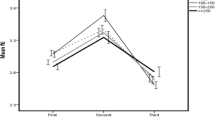Abstract
Maternal euthyroidism is important for fetal neural development. For this reason, adequate iodine nutrition during pregnancy is an important public health objective and should be periodically revised. The objective of this study was to measure urinary iodine (UI) excretion and the factors associated with thyroid volume (TV), in a group of healthy pregnant women in southern Brazil, to evaluate iodine nutrition. The median UI of the 147 women was 224 µg/l (P25=164 µg/l and P75=286 µg/l). Serum levels of free T4 and thyroglobulin did not correlate with UI, but there was a weak inverse correlation between serum TSH levels and UI (r=−0.200; p=0.02). TV, calculated through ultrasound in 57 women, was significantly associated with family history of thyroid diseases (p=0.002) and BMI (p=0.03), but there was no association with UI, corrected or not for creatinine, serum free T4, TSH or thyroglobulin, current or past smoking, gestational age, parity or oral contraceptive. Conclusions: The healthy pregnant women studied had adequate iodine intake. In this situation, the main thyroid size determinants are probably genetic factors.
Similar content being viewed by others
References
Morreale de Escobar G, Obregon MJ, Escobar del Rey F. Role of thyroid hormone during early brain development. Eur J Endocrinol 2004, 151(Suppl 3): U25–37.
Haddow JE, Palomaki GE, Allan WC, et al. Maternal thyroid deficiency during pregnancy and subsequent neuropsychological development of the child. N Engl J Med 1999, 341: 549–55.
Alexander EK, Marqusee E, Lawrence J, Jarolim P, Fischer GA, Larsen PR. Timing and magnitude of increases in levothyroxine requirements during pregnancy in women with hypothyroidism. N Engl J Med 2004, 351: 241–9.
Glinoer D. The regulation of thyroid function in pregnancy: pathways of endocrine adaptation from physiology to pathology. Endocr Rev 1997, 18: 404–33.
Glinoer D. The regulation of thyroid function during normal pregnancy: importance of the iodine nutrition status. Best Pract Res Clin Endocrinol Metab 2004, 18: 133–52.
Brander L, Als C, Buess H, et al. Urinary iodine concentration during pregnancy in an area of unstable dietary iodine intake in Switzerland. J Endocrinol Invest 2003, 26: 389–96.
WHO Secretariat, Andersson M, de Benoist B, Delange F, Zupan J. Prevention and control of iodine deficiency in pregnant and lactating women and in children less than 2-years-old: conclusions and recommendations. Public Health Nutr 2007, 10: 1606–11.
WHO, UNICEF, ICCIDD. Recommended Iodine Levels in salt and Guidelines for Monitoring their Adequacy and Effectiveness. In: Geneva WHO. WHO/NUT 96.13, 1996.
Food and Nutrition Board. Dietary Reference Intakes for Vitamin A, Vitamin K, Arsenic, Boron, Chromium, Copper, Iodine, Iron, Manganese, Molybdenum, Nickel, Silicon, Vanadium, and Zinc: The National Academy of Science, Washington, D.C. http://www.nap.edu/books/0309072794/html/; 2000.
Duarte G, Tomimori E, Boriolli R, et al. Echographic evaluation of the thyroid gland and urinary iodine concentration in school children from various regions of the State of Sao Paulo, Brazil. Arq Bras Endocrinol Metabol 2004, 48: 842–8.
Rossi A, Tomimori E, Camargo R, Medeiros-Neto G. Determination of thyroid volume by Sonography in healthy Brazilian schoolchildren. J Clin Ultrasound 2002, 30: 226–31.
Barca MF, Knobel M, Tomomori E, Cardia M, Zugaib M, Medeiros-Neto G. Aspectos ultra-sonográficos e prevalência da tireoidite pós-parto em gestantes sem disfunção tireóidea atendidas em hospital pùblico de São Paulo. Arq Bras Endocrinol Metabol 2001, 45: 180–9.
Knudsen N, Bols B, Bülow I, et al. Validation of ultrasonography of the thyroid gland for epidemiological purposes. Thyroid 1999, 9: 1069–74.
Pino S, Fang S, Braverman LE. Ammonium persulfate: a safe alternative oxidizing reagent for measuring urinary iodine. Clin Chem 1996, 42: 239–43.
Rasmussen L, Ovesen L, Christiansen E. Day-to-day and within-day variation in urinary iodine excretion. Eur J Clin Nutr 1999, 53: 401–7.
Als C, Helbling A, Peter K, Haldimann M, Zimmerli B, Gerber H. Urinary iodine concentration follows a circadian rhythm: a study with 3023 spot urine samples in adults and children. J Clin Endocrinol Metab 2000, 85: 1367–9.
Völzke H, Schwahn C, Kohlmann T, et al. Risk factors for goiter in a previously iodine-deficient region. Exp Clin Endocrinol Diabetes 2005, 113: 507–15.
Rotondi M, Amato G, Biondi B, et al. Parity as a thyroid size-determining factor in areas with moderate iodine deficiency. J Clin Endocrinol Metab 2000, 85: 4534–7.
Rotondi M, Sorvillo F, Mazziotti G, et al. The influence of parity on multinodular goiter prevalence in areas with moderate iodine deficiency. J Endocrinol Invest 2002, 25: 442–6.
Gómez JM, Maravall F, Gómez N, Gumà A, Soler J. Determinants of thyroid volume as measured by ultrasonography in healthy adults randomly selected. Clin Endocrinol (Oxf) 2000, 53: 629–34.
Rezvanian H, Aminorroaya A, Majlesi M, et al. Thyroid size and iodine intake in iodine-repleted pregnant women in Isfahan, Iran. Endocr Pract 2002, 8: 23–8.
Berghout A, Endert E, Ross A, Hogerzeil H, Smits N, Wiersinga W. Thyroid function and thyroid size in normal pregnant women living in an iodine replete area. Clin Endocrinol (Oxf) 1994, 41: 375–9.
Hansen P, Brix TH, Bennedbaek FN, Bonnema SJ, Kyvik KO, Hegedüs L. Genetic and environmental causes of individual differences in thyroid size: a study of healthy Danish twins. J Clin Endocrinol Metab 2004, 89: 2071–7.
Author information
Authors and Affiliations
Corresponding author
Rights and permissions
About this article
Cite this article
Soares, R., Vanacor, R., Manica, D. et al. Thyroid volume is associated with family history of thyroid disease in pregnant women with adequate iodine intake: A cross-sectional study in southern Brazil. J Endocrinol Invest 31, 614–617 (2008). https://doi.org/10.1007/BF03345612
Accepted:
Published:
Issue Date:
DOI: https://doi.org/10.1007/BF03345612




